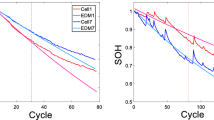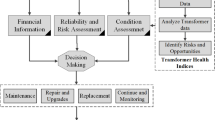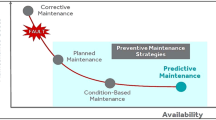Abstract
This paper proposes a novel hybrid algorithm for fault diagnosis of rotary kiln based on a binary ant colony (BACO) and support vector machine (SVM). The algorithm can find a subset selection which is attained through the elimination of the features that produce noise or are strictly correlated with other already selected features. The BACO algorithm can improve classification accuracy with an appropriate feature subset and optimal parameters of SVM. The proposed algorithm is easily implemented and because of use of a simple filter in that, its computational complexity is very low. The performance of the proposed algorithm is evaluated through two real Rotary Cement kiln datasets. The results show that our algorithm outperforms existing algorithms.
Similar content being viewed by others
References
R. Mahdaoui and L. H. Mouss, NEFDIAG, A new approach for industrial diagnosis by neuro-fuzzy systems: Application to manufacturing system, Proc. of ERIMA, 2(2) (2008) 144–151.
Z. Zhang, W. Cheng and X. Zhou, Research on intelligent diagnosis of mechanical fault based on ant colony algorithm, The Sixth International Symposium on Neural Networks, Springer Berlin, Heidelberg, 56 (2009) 631–640.
Q. Wu, Fault diagnosis model based on Gaussian support vector classifier machine, Expert Systems with Applications, 37(9) (2010) 6251–6256.
N. Wyse, R. Dubes and A. K. Jain, A critical evaluation of intrinsic dimensionality algorithms, Proc. of Pattern Recognition in Practice, Morgan Kaufmann Publishers, Inc, (1980) 415–425.
M. Dash and H. Liu, Feature selection methods for classifications, Intelligent Data Analysis, 3(1) (1997) 131–156.
A. L. Blum and P. Langley, Selection of relevant features and examples in machine learning artificial, Artificial Intelligence, 97 (1997) 245–271.
P. M. Narendra and K. Fukunaga, A branh and bound algorithm for feature subset selection, IEEE Transactions on Computers, 26 (1977) 917–922.
J. H. Yang and V. Honavar, Feature subset selection using a genetic algorithm, IEEE Intelligent Systems, 13(2) (1998) 44–49.
M. L. Raymer, W. F. Punch, E. D. Goodman, L. A. Kuhn and A. K. Jain, Dimensionality reduction using genetic algorithms, IEEE Transactions on Evolutionary Computation, 4(2) (2000) 164–171.
J. Kittler, Feature set search algorithms, Proc. of Pattern Recognition and Signal, C. H. Chen, editor, Sijhoff and Noordhoff, the Netherlands (1978).
O. Boz, Feature subset selection by using sorted feature relevance, International Conference on Machine Learning and Application, Las Vegas City (2002) 147–153.
I. Guyon and A. Elisseeff, An introduction to variable and feature selection, Journal of Machine Learning Research, 3 (2003) 1157–1182.
A. Al-Ani, Feature subset selection using ant colony optimization, International Journal of Computational Intelligence, 2(1) (2005) 53–58.
S. M. Vieira, J. C. Sousa and T. A. Runkler, Two cooperative ant colonies for feature selection using fuzzy models, Expert Systems with Applications, 37(4) (2010) 2714–2723.
C. L. Huang, ACO-based hybrid classification system with feature subset selection and model parameters optimization, Neurocomputing, 73 (2009) 438–448.
V. Maniezzo, M. Dorigo and A. Colorni, The ant system: Optimization by a colony of cooperating agents, IEEE Transactions on Systems, Man, and Cybernetics-Part B, 26(1) (1996) 29–41.
M. Dorigo and G. D. Caro, The ant colony optimization meta-heuristic, In New Ideas in Optimization, McGraw-Hill, London, UK (1999) 11–32.
W. N. Vapnik, An overview of statistical learning theory, IEEE Transactions of Neural Networks, 10 (1999) 988–999.
M. F. Pasha and R. Budtarto, Evolvable-NEURAL-based fuzzy inference system and its application for adaptive network anomaly detection, Advances in machine learning and cybernetics, 3930 (2006) 662–671.
X. Weiqing, Y. Chenyang and W. Liuyi, Binary ant colony evolutionary algorithm, International Journal of Information Technology, 12(3) (2006) 10–20.
E. Youn, Support vector-based feature selection using Fisher’s linear discriminant and Support Vector Machine, Expert Systems with Applications, 37(9) (2010) 6148–6156.
R. O. Duda, P. E. Hart and D. G. Stork, Pattern classification, Second Ed. Wiley Interscience Publication (2001).
S. O. Ogbeide, Developing an optimization model for CO2 reduction in cement production process, Journal of Engineering Science and Technology Review, 3(1) (2010) 85–88.
Author information
Authors and Affiliations
Corresponding author
Additional information
This paper was recommended for publication in revised form by Editor Sung-Lim Ko
Ouahab Kadri received his magister degree from the Department of Computer Science, University of Batna, Algeria, in 2004. He is currently an assistant professor at the University of Khenchela, Algeria. He is currently a Doctoral student in the Department of Industrial Engineering, University of Batna, Algeria. His current research interests include evolutionary computation, artificial intelligence, etc.
Leila Hayet Mouss was born in Batna, Algeria, in 1954. She received the B.Sc. degree in Electrical Engineering, in 1979, from the National Polytechnic School of Algiers, Algeria; the M.Sc. degree in Electrical and Computer Engineering, in 1982, from the ENSERB, France; and finally the Ph.D. degree also in Electrical and Computer Engineering, in 1985, Bordeaux University, France. After graduation, she joined the University of Batna, Algeria, where she is an Associate Professor of Electrical and Computer Engineering. Pr. Mouss is a member of New York Science Academy. She is the head of Automatic and Computer Integrated Manufacturing Laboratory. Pr. Mouss current research interests include industrial Diagnosis of production system using the artificial intelligence techniques in the LAP Lab (Laboratoire d’Automatique et Productique) at Batna, Algeria.
Rights and permissions
About this article
Cite this article
Kadri, O., Mouss, L.H. & Mouss, M.D. Fault diagnosis of rotary kiln using SVM and binary ACO. J Mech Sci Technol 26, 601–608 (2012). https://doi.org/10.1007/s12206-011-1216-z
Received:
Revised:
Accepted:
Published:
Issue Date:
DOI: https://doi.org/10.1007/s12206-011-1216-z




